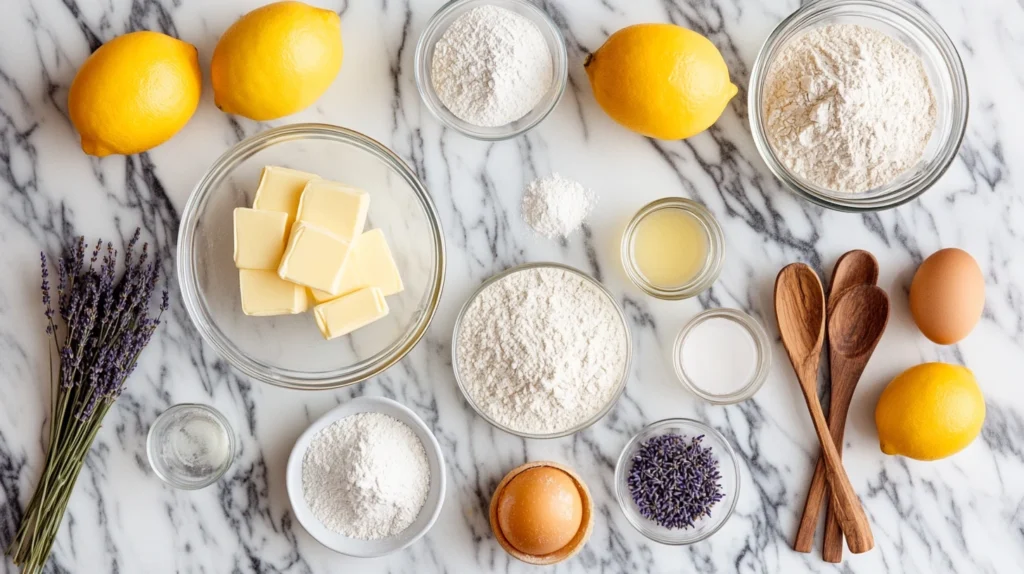There’s something undeniably elegant and refreshing about a Lemon Lavender Cookies recipe. Combining the zesty brightness of fresh lemon with the floral, calming notes of dried culinary lavender, these cookies are a delicate treat that delights the senses. With their crisp edges, soft centers, and light aroma, they’re the perfect fusion of sweet, tart, and subtly herbal.
Whether you’re baking for a springtime tea party, a bridal shower, or simply looking to elevate your everyday cookie game, these lemon lavender cookies add a touch of gourmet flair to your kitchen. Not only are they visually charming with a hint of pale lavender hue, but they’re also incredibly easy to make using simple pantry ingredients.
In this guide, you’ll discover how to make these bakery-worthy cookies from scratch—with step-by-step instructions, baking tips, and optional glaze ideas to add an extra pop of flavor. Ready to impress with a batch of beautifully aromatic cookies? Let’s dive in!

The Origins of Lemon Lavender Cookies
The pairing of lemon and lavender might seem trendy in modern kitchens, but the roots of this flavor combination trace back centuries. Both ingredients have long been celebrated in culinary and medicinal traditions, particularly across the Mediterranean and European regions.
Lavender, known for its calming scent and delicate purple blooms, has been used for thousands of years. The ancient Egyptians incorporated lavender in perfumes and oils, while the Greeks and Romans used it for cooking, bathing, and healing. Culinary lavender — a specific, edible variety of the plant — was traditionally steeped in teas or used sparingly in desserts for its gentle floral flavor.
Lemon, on the other hand, has always been a symbol of freshness and vitality. Originating from Asia, lemons found their way into Europe via the Middle East during the Crusades. With their high vitamin C content and vibrant acidity, lemons became a beloved ingredient in both sweet and savory dishes.
It was only a matter of time before bakers experimented with combining the two. The sharp, zesty punch of lemon balances the soothing, almost minty undertone of lavender beautifully. This marriage of flavors became particularly popular in French patisserie, where floral and citrus notes often coexist in elegant desserts.
Today, the lemon lavender cookie is a modern take on these timeless traditions — refined yet accessible, nostalgic yet innovative. Whether found in a boutique bakery in Provence or whipped up in your home kitchen, these cookies are a testament to the power of simple, natural ingredients coming together in perfect harmony.
Essential Ingredients List

Before you begin baking, it’s essential to gather all your ingredients. Each component plays a specific role in achieving that buttery, crumbly, aromatic cookie texture and taste. Here’s a breakdown of what you’ll need:
- 1 cup (2 sticks) unsalted butter, softened
- 3/4 cup granulated sugar
- 1 large egg
- 2 tablespoons lemon zest (from about 2 lemons)
- 2 tablespoons fresh lemon juice
- 1 teaspoon pure vanilla extract
- 2 cups all-purpose flour
- 1/2 teaspoon baking powder
- 1/4 teaspoon salt
- 1 to 1½ teaspoons dried culinary lavender (lightly crushed)
Optional Add-ons:
- Powdered sugar for dusting
- Lemon glaze (a mix of lemon juice and powdered sugar) for drizzling
- Lavender sugar (for rolling or topping)
These simple ingredients come together to create cookies that are rich in flavor and beautifully aromatic. The key is to use high-quality, fresh ingredients — especially when it comes to lemon and lavender. Fresh lemon juice and zest give the cookies a punchy brightness, while dried culinary lavender provides the soft floral undertone that makes them so unique.
Ingredient Spotlight
Let’s take a closer look at the two main stars of this recipe: lemon and lavender.
Lemon: Lemons offer more than just sourness. The zest contains fragrant essential oils that add depth to baked goods, while the juice provides acidity that enhances flavor balance. Lemons are also packed with vitamin C and antioxidants, making them a healthy addition to your sweets.
Lavender: When using lavender in baking, it’s crucial to select culinary-grade lavender, such as English lavender (Lavandula angustifolia). It should be dried, but not overly processed. Lavender is known to promote relaxation, reduce stress, and support sleep — a cookie that calms you? Yes, please!
Butter and Sugar: The base of the dough relies on butter and sugar creamed together until light and fluffy. This creates the tender, shortbread-like texture that melts in your mouth.
Egg and Vanilla: The egg binds the ingredients and adds richness, while vanilla extract enhances the flavor and smooths out the citrus and herbal notes.
Flour, Baking Powder, and Salt: These dry ingredients provide structure and a slight lift, with salt subtly balancing the sweet and floral elements.
Love floral desserts? You might also enjoy these Lavender White Chocolate Truffles – A Floral Delight, which melt in your mouth with a similar delicate floral note.
Tools and Equipment Needed
Having the right tools at hand makes the baking process smooth and enjoyable. For this lemon lavender cookies recipe, you won’t need any fancy gadgets, just a few kitchen staples:
- Mixing bowls (medium and large) – For combining wet and dry ingredients separately.
- Measuring cups and spoons – To ensure ingredient accuracy.
- Microplane or fine grater – For zesting lemons finely.
- Citrus juicer – Helps extract every drop of lemon juice.
- Electric hand mixer or stand mixer – For creaming butter and sugar.
- Rubber spatula or wooden spoon – To scrape the bowl clean and fold in ingredients.
- Baking sheet – Prepare with parchment paper or a silicone baking mat to prevent sticking and simplify cleanup.
- Cookie scoop or spoon – Ensures uniform cookie sizes.
- Cooling rack – To cool cookies evenly after baking.
- Plastic wrap – For chilling the dough if needed.
While none of these tools are complicated, using the proper equipment can make a big difference in the consistency and appearance of your cookies.
Step-by-Step Lemon Lavender Cookies Recipe Guide
Now it’s time to get baking! This step-by-step guide will walk you through everything from preparing your dough to infusing it with lemon and lavender, all the way to perfectly baking your cookies.
Prepping the Dough for Your Lemon Lavender Cookies
- Cream the Butter and Sugar:
In a large mixing bowl, cream the softened butter and granulated sugar together until the mixture is pale, smooth, and fluffy in texture. This usually takes about 2–3 minutes with an electric mixer on medium speed. Creaming incorporates air and sets the stage for a delicate texture. - Add the Wet Ingredients:
Add the egg and beat until it’s fully blended into the mixture. Then, stir in the vanilla extract, freshly squeezed lemon juice, and lemon zest. These ingredients work together to give the dough its bright, citrusy base. - Combine the Dry Ingredients Separately:
In a medium bowl, whisk together the flour, baking powder, salt, and culinary lavender. Crushing the lavender slightly between your fingers or in a mortar and pestle releases more aroma without overwhelming the dough. - Incorporate Dry into Wet:
Gradually add the dry mixture into the wet mixture, stirring on low speed or by hand. Mix just until everything comes together. Don’t overmix — that could lead to dense cookies instead of light, buttery ones. - Chill the Dough (Optional):
If your dough feels sticky or soft, cover it with plastic wrap and chill it in the refrigerator for 20–30 minutes. This helps the dough firm up and prevents cookies from spreading too much during baking.
Infusing Lemon and Lavender Flavors
The real magic in these cookies lies in how the lemon and lavender flavors are infused throughout the dough.
- Lemon Zest & Juice:
Lemon zest brings an intense citrus aroma, while the juice adds brightness and a gentle tang. Be sure to zest only the yellow part of the peel — the white pith underneath is bitter. - Lavender Crystals:
Dried culinary lavender should be used sparingly. Too much can overpower your cookies and make them taste soapy. About 1 to 1½ teaspoons is ideal for a batch, depending on your preference. Crushing the lavender just before using it releases the essential oils and enhances the floral notes. - Balance is Key:
The sweet, buttery base of the dough allows the lemon and lavender to shine. The zest and lavender mingle during mixing and baking, resulting in cookies that are fragrant, but not overpowering.
Shaping and Baking Instructions
- Preheat the Oven:
Preheat the oven to 350°F (175°C) and prepare a baking sheet by lining it with parchment paper or a silicone mat. - Shape the Cookies:
Use a cookie scoop or tablespoon to scoop out evenly sized dough balls. Roll them lightly in your palms and place them about 2 inches apart on the baking sheet. - Bake the Cookies:
Bake for 10 to 12 minutes, or until the edges are lightly golden and the centers look just set. Keep an eye on them, as overbaking can dry them out. The centers should look slightly underdone — they’ll continue to cook as they cool. - Cool Completely:
Let the cookies sit on the baking sheet for 2–3 minutes after removing them from the oven, then transfer them to a wire rack to cool fully. This helps maintain the right texture — crisp on the edges and soft in the center. - Optional Glaze or Sugar Dusting:
For a touch of elegance, drizzle a lemon glaze over the cooled cookies or sprinkle them lightly with powdered sugar or lavender sugar.
Fan of flaky, buttery pastries? Check out these Irresistible Cinnamon Sugar Cruffins – Easy & Flaky Treat for a cozy, bakery-style experience at home.
Nutritional Facts & Health Benefits of Lemon Lavender Cookies
While cookies are certainly a delightful treat, understanding what goes into them is key to making mindful choices—especially when baking from a lemon lavender cookies recipe using fresh, high-quality ingredients. By making these cookies at home, you gain complete control over every ingredient, turning this sweet recipe into a thoughtful and wholesome indulgence.
Here’s an approximate nutritional profile per cookie (based on a batch yielding 24 cookies):
- Calories: 135
- Total Fat: 7g
- Saturated Fat: 4g
- Carbohydrates: 16g
- Sugar: 8g
- Protein: 1.5g
- Fiber: 0.3g
Health Benefits of Key Ingredients:
Lemon
- High in vitamin C, lemons support immune function and skin health.
- Natural detoxifier with antioxidant properties.
- Lemon zest contains essential oils that can aid digestion.
Lavender
- Known for its relaxing and calming effects, lavender has been used in aromatherapy and wellness for centuries.
- Some studies suggest that lavender may help reduce anxiety and support restful sleep.
- Contains polyphenols and antioxidants in small amounts.
Butter (in moderation)
- Provides richness and texture to baked goods.
- Provides fat-soluble vitamins such as A, D, E, and K.
Flour and Eggs
- Flour gives structure, while eggs add protein and moisture.
- Eggs also act as a binder and help emulsify the fats and liquids in the dough.
Is It a Health Food?
While lemon lavender cookies aren’t “health food,” they are a better-for-you option when made at home. You control the quality of ingredients, the amount of sugar, and even the fat content if you choose to make substitutions (like replacing half the butter with Greek yogurt or using a sugar substitute).
These cookies can also fit nicely into a balanced lifestyle — a little indulgence with a refreshing twist. Serve them with herbal tea or as a mid-afternoon treat when you need a gentle pick-me-up.
Creative Twists on the Lemon Lavender Cookies Recipe & Serving Ideas

One of the best things about this lemon lavender cookies recipe is how easily you can customize it to suit your taste or any occasion. Whether you’re baking for spring, gifting loved ones, or simply craving a floral treat, this recipe offers endless room for creativity. From citrusy glazes to lavender sugar toppings, every variation brings out the delicate balance of lemon and lavender in a unique way.
1. Glazed Lemon Lavender Cookies
Whisk together powdered sugar and fresh lemon juice to create a simple, tangy glaze. Drizzle it over the cooled cookies for added sweetness and a beautiful shine. For an elegant finish, sprinkle a pinch of crushed lavender on top before the glaze sets.
2. Lemon Lavender Sandwich Cookies
For a more decadent version, spread a thin layer of lemon curd, lavender honey, or white chocolate ganache between two cookies to make delicate sandwich cookies. These are ideal for tea parties, weddings, or baby showers.
3. Lavender Shortbread Style
Looking for a firmer, more buttery bite? Omit the egg to transform your cookies into a shortbread-style version. You’ll get a melt-in-your-mouth texture that pairs perfectly with tea or coffee.
4. Add a Floral Sugar Topping
Enhance flavor and texture by rolling each dough ball in lavender-infused sugar before baking. You can make this by blending granulated sugar with crushed culinary lavender a few days ahead. The result? Crunchy edges, subtle floral notes, and sparkling tops.
5. Gluten-Free Lemon Lavender Cookies
Need a gluten-free option? Simply swap the all-purpose flour for a 1:1 gluten-free flour blend. Make sure it contains xanthan gum, or add ¼ teaspoon to maintain the structure and chewy texture.
6. Decorate for Seasonal or Special Occasions
Have fun with shapes and colors! Use cookie cutters to form hearts, flowers, or stars. Glaze or ice with pastel shades to match spring celebrations, birthdays, or baby showers. These cookies make stunning edible gifts or party favors.
Serving Suggestions:
- Pair with a cup of Earl Grey tea, chamomile, or lavender lemonade for a full sensory experience.
- Serve as part of an afternoon tea spread with scones, jam, and finger sandwiches.
- Wrap in clear cellophane bags with ribbon for a DIY edible gift or wedding favor.
Whether you’re baking for a party, relaxing at home, or preparing something unique to share with friends, lemon lavender cookies are sure to impress with both flavor and charm.
Frequently Asked Questions
Do lemon and lavender go together?
Yes, lemon and lavender pair beautifully together — both in scent and in flavor. Lemon brings a zesty, citrusy brightness, while lavender adds a soft floral and slightly herbal note. When used in balance, this combination creates a refreshing, calming, and elegant flavor profile, especially in baked goods like cookies, cakes, and scones. It’s a popular pairing in French desserts and modern wellness recipes because it stimulates both the taste buds and the senses.
What Does Lemon Juice Do in a Lemon Lavender Cookies Recipe?
Lemon juice in cookie dough serves several purposes. First, it adds a tangy, citrusy flavor that brightens the entire cookie. Second, the acid in lemon juice reacts with the baking powder or baking soda, helping the cookies to rise and become tender. Lastly, the slight acidity can help balance the sweetness of the sugar, giving the cookie a more complex and pleasant flavor. Just be careful not to add too much liquid, or it may affect the dough’s texture.
How to Use Lavender in Baking and in a Lavender Cookies Recipe
To use lavender in baking, always choose culinary-grade dried lavender, preferably from the English variety (Lavandula angustifolia). Here are a few tips:
- Crush the buds slightly with a mortar and pestle to release their natural oils.
- Use 1 to 1½ teaspoons per batch of cookies or cake batter — lavender can quickly become overpowering.
- Pair it with citrus (like lemon or orange) to balance the floral notes.
- Mix it into doughs, batters, or sugar for gentle infusions.
Avoid using ornamental or non-edible lavender, as it can taste bitter or be chemically treated.
What strain is lavender cookies?
“Lavender Cookies” is also the name of a cannabis strain, distinct from the edible lemon lavender cookies recipe. This strain is typically an indica-dominant hybrid, known for its calming, relaxing effects and fragrant, floral aroma. It’s often created by crossing Girl Scout Cookies with Lavender Kush, resulting in a smooth, herbal taste with sweet undertones. If you’re referring to the baked treat, rest assured — it’s 100% cannabis-free and family-friendly unless otherwise specified.
Conclusion

If you’re looking for a cookie that’s as beautiful as it is delicious, this Lemon Lavender Cookies recipe delivers on every level. The citrusy zing of lemon pairs perfectly with the floral fragrance of lavender, creating a cookie that feels light, sophisticated, and utterly delightful. Whether you drizzle them with lemon glaze or enjoy them plain, they’re sure to steal the show at any gathering—or make your afternoon tea that much more special.
Now that you’ve mastered this easy yet elegant recipe, don’t be surprised if friends and family start requesting them again and again. Keep some dried lavender on hand, zest a lemon or two, and you’ll always be ready to whip up a batch of these irresistibly fragrant treats.
Happy baking—and don’t forget to share the love (and cookies)!

🍪 Lemon Lavender Cookies Recipe
Equipment
- Mixing bowls (1 large, 1 medium)
- Measuring cups and spoons
- Microplane or fine grater (for lemon zest)
- Citrus juicer
- Electric mixer or hand mixer
- Silicone spatula or wooden spoon
- Baking sheet
- Parchment paper or silicone baking mat
- Cookie scoop or spoon
- Wire cooling rack
- Plastic wrap (for chilling dough)
Ingredients
- 1 cup 2 sticks unsalted butter, softened
- 3/4 cup granulated sugar
- 1 large egg
- 2 tablespoons lemon zest from ~2 lemons
- 2 tablespoons fresh lemon juice
- 1 teaspoon pure vanilla extract
- 2 cups all-purpose flour
- 1/2 teaspoon baking powder
- 1/4 teaspoon salt
- 1 to 1½ teaspoons dried culinary lavender crushed
- Optional:
- Powdered sugar for dusting
- Lemon glaze 1/2 cup powdered sugar + 1–2 tsp lemon juice
- Lavender sugar for rolling or topping
Instructions
- Preheat your oven to 350°F (175°C) and line a baking sheet with parchment paper or a silicone mat.
- In a large bowl, cream the butter and sugar until light and fluffy (2–3 minutes).
- Add the egg, lemon zest, lemon juice, and vanilla extract. Mix until combined.
- In a separate bowl, whisk together flour, baking powder, salt, and crushed lavender.
- Gradually add the dry ingredients to the wet ingredients. Mix until a soft dough forms.
- If the dough is soft, chill in the fridge for 20–30 minutes.
- Use a cookie scoop to portion dough balls onto the baking sheet, spacing 2 inches apart.
- Bake for 10–12 minutes, or until edges are lightly golden.
- Let cookies cool on the baking sheet for 2 minutes, then transfer to a wire rack.
- Optional: Once cool, drizzle with lemon glaze or dust with powdered sugar.

